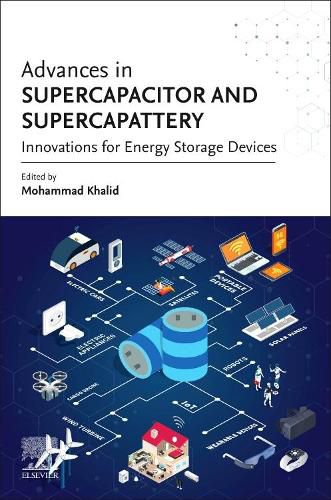Readings Newsletter
Become a Readings Member to make your shopping experience even easier.
Sign in or sign up for free!
You’re not far away from qualifying for FREE standard shipping within Australia
You’ve qualified for FREE standard shipping within Australia
The cart is loading…






Advances in Supercapacitor and Supercapattery: Innovations in Energy Storage Devices provides a deep insight into energy storage systems and their applications. The first two chapters cover the detailed background, fundamental charge storage mechanism and the various types of supercapacitor. The third chapter give details about the hybrid device (Supercapattery) which comprises of battery and capacitive electrode. The main advantages of Supercapattery over batteries and supercapacitor are discussed in this chapter. The preceding three chapters cover the electrode materials used for supercapattery. The electrolyte is a major part that significantly contributes to the performance of the device. Therefore, different kinds of electrolytes and their suitability are discussed in chapter 6 and 7. The book concludes with a look at the potential applications of supercapattery, challenges and future prospective. This book is beneficial for research scientists, engineers and students who are interested in the latest developments and fundamentals of energy storage mechanism and clarifies the misleading concepts in this field.
$9.00 standard shipping within Australia
FREE standard shipping within Australia for orders over $100.00
Express & International shipping calculated at checkout
Advances in Supercapacitor and Supercapattery: Innovations in Energy Storage Devices provides a deep insight into energy storage systems and their applications. The first two chapters cover the detailed background, fundamental charge storage mechanism and the various types of supercapacitor. The third chapter give details about the hybrid device (Supercapattery) which comprises of battery and capacitive electrode. The main advantages of Supercapattery over batteries and supercapacitor are discussed in this chapter. The preceding three chapters cover the electrode materials used for supercapattery. The electrolyte is a major part that significantly contributes to the performance of the device. Therefore, different kinds of electrolytes and their suitability are discussed in chapter 6 and 7. The book concludes with a look at the potential applications of supercapattery, challenges and future prospective. This book is beneficial for research scientists, engineers and students who are interested in the latest developments and fundamentals of energy storage mechanism and clarifies the misleading concepts in this field.